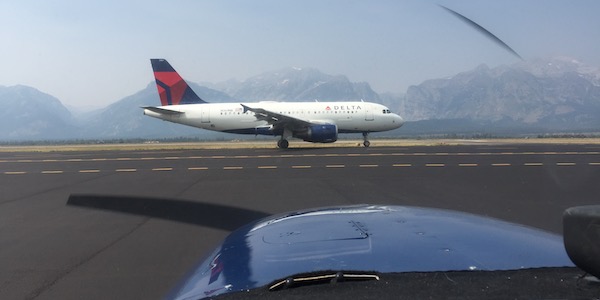What comes to mind when you read that title? Mountains? Traffic? Sunrises and sunsets? Well, what I’m talking about is a bit more technical than that. “What can you see when you fly?” is a great question to ask yourself and as a CFI, to ask the student! Make sure that effective communication can take place during maneuvering flight.
I am 6 feet tall, with a pretty even spread between leg and torso length. I sit in the 172 with the seat almost all the way up, maybe 3 or 4 cranks shy of the top. This affords me a great view forward with little obstruction from the instrument panel or cowling. This does mean I have to bend my neck down a bit when looking out the left and right window, but this occurs far less than the time I spend looking out the front.
If I know I’m going to be flying in Instrument Meteorological Conditions (IMC), I may put the seat a couple cranks lower to favor the instruments, but not so low that I have to crane my neck when I pop out of the clouds during the approach to landing. Due to these situations, another question is asked along with “what can you see when you fly”… “what do I WANT to see when I fly?”
As a CFI teaching student and commercial pilot candidates, we spend a majority of our training in the maneuvering phase of flight. During this phase, we’re paying attention to the nose position during steep turns, lazy 8’s, chandelles, and stalls. We’re also paying attention to the nose and looking out the side window when doing steep spirals and 8’s on pylons.
Earlier, I mentioned how I have a pretty even spread between my torso and leg length. If I fly with a student who has the same torso length as me, they could set their seat at the same height as mine, and we would see the same sight picture (with a little parallax from left to right). But what if that student’s medical said that they were only 68 inches instead of my 72? They have the same torso length, so where’s the 4 inches missing from? If you answered the legs, pat yourself on the back. This may mean that the station of the chair will need to be different than mine, skewing their sight picture slightly.
If you have students or are a student with a shorter torso, make sure to set the seat height all the way up to maximize forward visibility. Most flight schools have pads or pillows to raise your height OR move you forward in the seat. Some students I’ve flown with in the past needed one or even both pads to get them to where they can see effectively.
One easy tool I use in the 172 (as early as flight #2) is my hand on the cowling. Once a student is comfortable, I’ll place my hand on the cowling on the 3rd rivet forward of the windscreen. If they can see my hand without craning their neck, I know they’re sitting high enough and will see the same things I see throughout all phases of flight. Having the same view will actually help with effective training.
“What can you see when you fly?” How about pitch, roll, and yaw! Intended and unintended motions. Pitch attitudes, rates of turn, crab angles… and many more! The only way to accomplish that is to make sure the seating position allows it.
Now, there are very rare instances where it’s just not possible to get an ideal seating position. One can certainly still learn with alternate sight pictures (think learning to taxi a tailwheel airplane, use what you’ve got and don’t worry about what you don’t), but the CFI must recognize and communicate what these are.
My last comment on this topic has to do with avoiding parallax and making an easier transition between left and right seats. For those CFI’s reading this, you may recall having a hard time landing the aircraft during those first couple hours from the right seat. Part of this comes down to how you learned from the left seat in the first place. The flight instructor often says “look at the nose”. The student’s reaction is to look through the spinner, which is in the center of the cowl. But unless you’re learning in a tandem seat aircraft, the pilot isn’t sitting in the center of the aircraft. The pilot actually learns to fly by looking to the right and skewing all sight pictures with a bias to the right. Then when they make the transition to the right seat, all the biases are now to the left because the spinner is to the left!
From the beginning, teach the student to always look straight ahead to determine where the aircraft is pointed. Sitting with your back firmly against the seatback, imagine a narrow beam coming out of your chest and shining straight ahead. This is where the eyes should go. Don’t look through the spinner. On the 172, there’s usually two rivet lines on the cowling. Don’t let your eyes cross over that rivet line! Most Pipers have a hump in the center of the cowl — don’t look across that. If you follow these guidelines, the transition between seats will be easier, maneuvers will improve drastically, and instruction given by the CFI will be better received by students.

